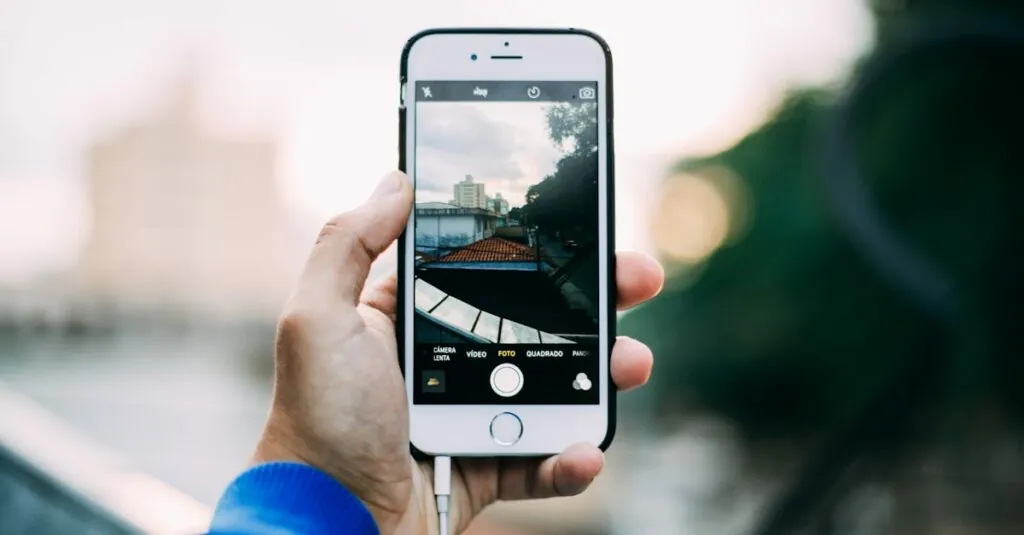Table of Contents
ToggleIn a world where selfies reign supreme and every sunset deserves its moment of fame, having photo access on an iPhone is crucial. Imagine trying to capture that perfect shot of your lunch only to be met with a message that makes you feel like you’re locked out of a secret club. Fear not! Enabling photo access is easier than finding the filter that makes you look ten years younger.
Understanding Photo Access on iPhone
Photo access plays a vital role in maximizing the functionality of an iPhone. Users miss opportunities to capture memories and share experiences without it.
Importance of Photo Access
Photo access enables users to take advantage of their device’s camera features. It allows for seamless integration with apps that enhance creativity, such as social media platforms and photo editing tools. Capturing spontaneous moments fosters connection and communication. Without access, users face missed chances to document life events and express themselves. Proper enabling supports better organization and sharing of visual content. Trust in the device’s capabilities increases with easy access to images.
Common Scenarios Requiring Photo Access
Common scenarios requiring photo access include sharing special moments with friends and family. Users often upload photos to social media, wanting immediate visibility. Apps such as messaging platforms benefit from the ability to send images directly. Editing photos in creative apps calls for easy access to the photo library. Events like vacations or celebrations involve capturing numerous pictures. Quicker access simplifies the management of photo albums and memories. Engaging with photo-related apps enhances overall user experience on the device.
Steps to Enable Photo Access
Enabling photo access on an iPhone takes only a few straightforward actions. Follow these detailed steps to get started.
Accessing Settings
To begin, locate the Settings app on your iPhone. It’s typically found on the home screen. Tapping on the app opens a menu with various options. Scroll down to find “Privacy,” a key section for managing app permissions. Selecting this will lead to further choices related to your data and privacy settings.
Navigating to Privacy Settings
Privacy settings provide options for different types of data access. Once in the Privacy menu, look for the “Photos” option. This option lists all apps that have requested access to your photo library. Each entry indicates whether the app has permission to access your photos, helping you make informed choices about your privacy.
Allowing Photo Access for Specific Apps
Enabling photo access for individual apps is simple. After selecting “Photos,” view the list of apps. Tap on any app to access its settings. You’ll see options like “Read and Write” or “Read Only.” Choose the desired setting to grant appropriate access. Adjusting settings also helps ensure you share only what you intend with different apps.
Troubleshooting Photo Access Issues
When facing difficulties accessing photos on an iPhone, specific steps help resolve the issue. Ensuring the device settings match required permissions is essential for a seamless experience.
Checking App Permissions
Start by reviewing the app permissions for photo access. Open the Settings app, then tap on Privacy. Under Privacy, select Photos to reveal a list of apps requesting access to the photo library. Check each app’s permissions to confirm they’re set to either Read and Write or Read Only. If an app lacks necessary permissions, simply tap on the app and adjust the settings accordingly. This ensures that each application can function effectively with access to stored images.
Restarting Your iPhone
Another effective step involves restarting the iPhone. By turning off the device and turning it back on, users can refresh the system. Restarting resolves temporary glitches that may affect photo access. Hold down the power button until the option to slide to power off appears. Once the iPhone powers down, wait a few moments before turning it back on. Re-checking photo access after this action can eliminate access issues, bringing the device back to optimal functionality.
Additional Tips for Managing Photo Access
Managing photo access on an iPhone ensures efficient organization and sharing of images. Implementing these tips enhances user experience and streamlines photo management.
Using iCloud Photos
Using iCloud Photos provides a convenient way to manage photos across multiple devices. Syncing images automatically guarantees they remain updated on all devices. Users can organize photos into albums, making them easy to find. To maximize this feature, enabling iCloud in Settings and selecting “Photos” allows seamless integration. Accessing the iCloud library from any device with the same Apple ID ensures flexibility and instant sharing. Users can also optimize storage by keeping only recent photos downloaded on the iPhone while maintaining the full library in the cloud.
Third-Party Photo Management Apps
Third-party photo management apps offer additional tools for users seeking advanced features. Applications like Google Photos and Adobe Lightroom allow more extensive editing options and enhanced organization. Users can categorize photos using tags, location data, or dates, making retrieval straightforward. After downloading any app, granting necessary permissions to access the photo library ensures full functionality. Additionally, users can benefit from features like automatic backup and different sharing options, which help manage photos effectively. Integrating these apps enhances overall management, allowing users to maintain a well-organized photo collection.
Enabling photo access on an iPhone opens up a world of possibilities for capturing and sharing life’s moments. With simple steps to adjust permissions users can ensure they have the flexibility to manage their photos effectively. Troubleshooting any access issues is straightforward and can often be resolved with a few quick adjustments or a device restart.
Utilizing iCloud Photos and third-party apps can further enhance the photo management experience. By following these tips users can maximize their device’s capabilities and enjoy seamless integration with their favorite social media platforms and editing tools. Embracing these features not only enriches creativity but also fosters connections through shared experiences.





